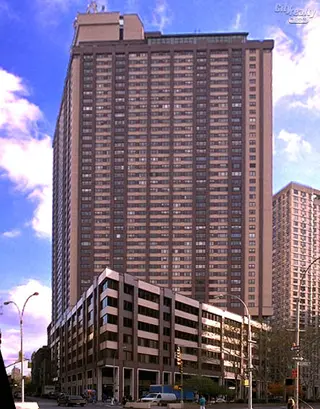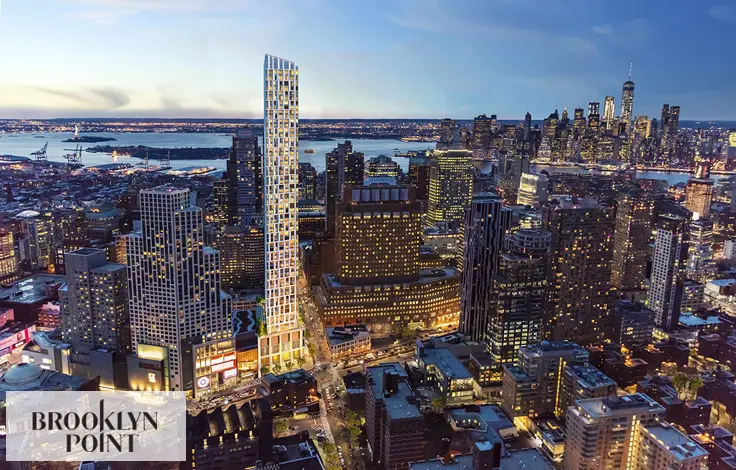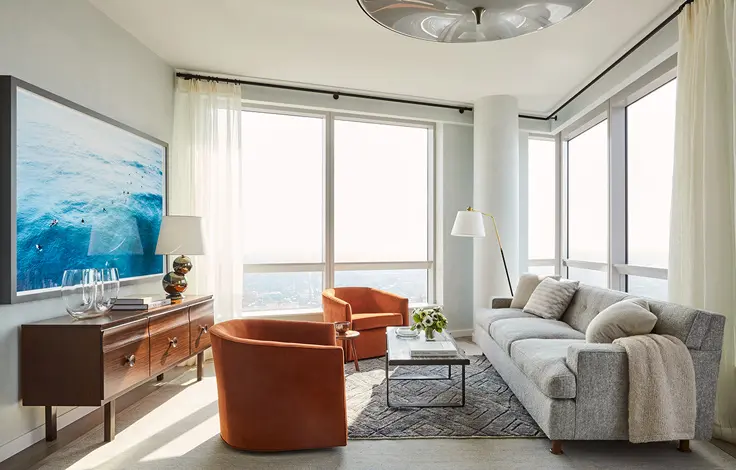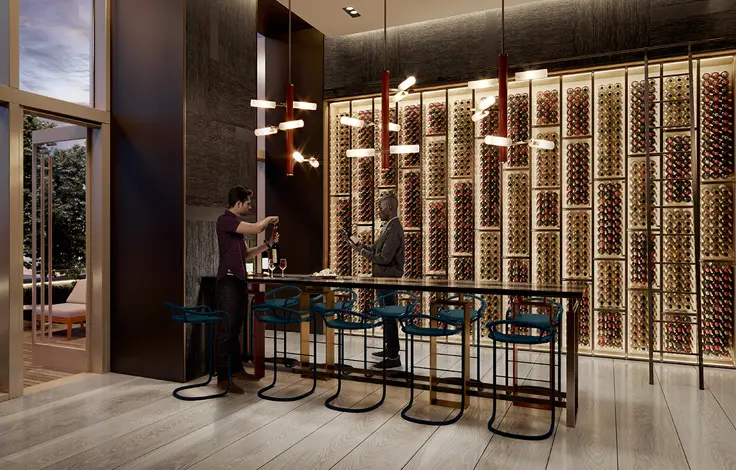 Carter Horsley
Carter HorsleyApr 09, 2012
Carter's Review
Erected in 1971, One Lincoln Plaza is a 43-story building that takes up the entire frontage on Broadway between 63rd and 64th Streets and has a deep arcade along Broadway. It has an angled, setback tower on a low-rise base that frames a mid-block, landscaped plaza.
It was developed by the Milstein organization that would build a smaller apartment tower one block to the south that is notable for its Broadway arcade, its attractive, mid-block landscaped plaza and the building’s multiple bay windows.
One Lincoln Plaza was the first major apartment building to be built in the area after the Lincoln Center for the Performing Arts opened in the 1960s.
It contains 663 residential condominium apartments.
Bottom Line
The good thing about going first as a developer is that you get the best location.
This huge apartment building stands across Broadway and Amsterdam Avenue from the central plaza at the Lincoln Center for the Performing Arts and therefore is the dominant building in the Lincoln Square area even though it’s not the tallest.
Since it was erected in 1971, it has been hemmed in a bit by other residential towers but it constantly renewed by its great arcade and sidewalk cafes including the stand-up frankfurter bar at Cafe Boulud at the 65th Street corner.
Description
This tower is distinguished by its two-tone façade of beige and dark brown brick that provides vertical accents to the tower, scores of satellite dishes around its rooftop bulkhead, and its bent, angled form.
The tower is directly across Broadway from the large plaza with a fountain at the center of Lincoln Center that was redesigned in 2011.
To the east, a new luxury apartment tower was erected in 2001 in the nook of its bent angled tower thereby obstructing some of this tower's direct views to the east and Central Park. That tower, which uses air rights from the adjacent Romanesque-style YMCA building, is very attractive and was designed by Beyer, Blinder, Belle.
While the overall appearance of One Lincoln Plaza is a bit prosaic, its form is excellent and it holds the angled street-line of Broadway very well.
One Lincoln Plaza incorporated an eight-story base that has office space for the American Society of Composers, Authors and Publishers (ASCAP), as well as other tenants, and an arcade facing Broadway with many active sidewalk cafes.
Amenities
One Lincoln Plaza has a roof deck, a concierge, a health club with swimming pool, a garden, and a garage but no balconies.
Several restaurants in its base have sidewalk cafes.
It is only a few blocks north of Columbus Circle where the Time-Warner Center replaced the former New York Coliseum and that twin-towered, mixed-use building features a large and popular Whole Foods store in its basement.
Apartments
There are many different apartment layouts.
Penthouse V has a10-foot-wide entry foyer that leads on one side to a 20-foot-lont dining area/enclosed kitchen and on the other side to a 22-foot-long living room.
Apartment 11V is a one-bedroom unit with a small enclosed kitchen just off the entry foyer that leads to a 22-foot-long living room.
Apartment 12K is a two-bedroom unit with a very large L-shaped living room that leads to a small dining area off the enclosed kitchen.
Apartment 14D is another two-bedroom unit with a foyer that leads into a 30-foot-long living room that opens onto a 15-foot-long angled dining room adjacent to a 17-foot-long kitchen.
Apartment 26DE is a five-bedroom unit with a 36-foot-long living room and a 29-foot-long dining room.
Apartment 32RS is a two-bedroom unit with a 21-foot-long living room adjacent to a 17-foot-long dining room off an 16-foot-long, pass-through kitchen. The apartment also has a den next to the living room with a sliding door and a 22-foot-long master bedroom with an 11-foot-long dressing room.
History
Some design critics were less than enthusiastic about the quality of this building when it opened as it is the most visible building in the area for those attending cultural events at Lincoln Center.
The center has spurred considerable residential construction in its vicinity, especially at the north end where numerous towers were erected with multi-level retail spaces.
This bustling area has many restaurants and stores and excellent public transportation.
In their book, "New York 1960, Architecture and Urbanism Between The Second World War and the Bicentennial," Robert A. M. Stern, Thomas Mellins and David Fishman provided the following commentary relating to this site:
"In November 1966, following the completion of the Metropolitan Opera House, the architect William F. R. Ballard, who served as chairman of the City Planning Commission, proposed the construction of a monumental mall connecting Lincoln Center's main plaza with Central Park to the east. The landscaped mall was intended to fully occupy the block bounded by Broadway, Central Park West, Sixty-third and Sixty-fourth streets; a 1,000-car garage would be located beneath it. The mall had the support of Wallace Harrison who, along with other members of his advisory committee, had ten years earlier advocated the organization of Lincoln Center around a central plaza, which they hoped would ultimately be approached by a grand allee leading from Central Park.”
“Ballard's plan...called on the city to acquire the property as parkland through eminent domain and would have necessitated the demolition of three architecturally significant buildings: the Ethical Culture Society School (Robert D. Kohn and Carrere & Hastings, 1902), on the northwest corner of Central Park West and Sixty-third Street; the adjacent Ethical Culture Society Hall (Robert D. Kohn, 1911), on the southwest corner of Central Park West and Sixty-fourth Street; and the West Side Branch of the YMCA (Dwight James Baum, 1930), at 5 West Sixty-third Street...."
That plan, however, got strong opposition from Ethical Culture and the YMCA and the New York Academy of Science that owned the western end of the block and had cleared it for a new headquarters building.
An alternate plan was presented by Raymond Loewy/William Snaith Inc. that called for tall buildings the block between Broadway and Central Park West that would be spaced widely to provide unobstructed view between Lincoln Center and Central Park. Pedestrian walkways on a second level were also included.
Eventually, in 1969, the city enacted a 15-block, special zoning district for the area and One Lincoln Plaza became the first building to be erected under its provisions was Seymour Milstein had acquired by then the New York Academy of Science site.
The authors noted that "Once the special district became law, Milstein, 'playing skillfully on the institutional jealousies between City agencies,' convinced the Board of Standards and Appeals to give him an additional 20 percent floor bonus over the bonus already allowed by the special district.”
In the fourth edition (2000) of the great book, “The A. I. A. Guide to New York City,” Elliot Willensky and Norval White described this building as “another behemoth from the Lincoln Center syndrome,” adding that “the overwhelming skewed prism has no redeeming social or architectural significance. The public arcade only allowed it to be bigger – what an urbanistic mistake!”
In time, One Lincoln Plaza’s prominent skyline isolation lessened significantly with new high-rise construction in the area.

- Condo built in 1974
- 2 apartments currently for sale ($2.995M to $3.2M)
- 2 apartments currently for rent ($0)
- Located in Lincoln Center
- 663 total apartments 663 total apartments
- 10 recent sales ($950K to $2.2M)
- Doorman
- Pets Allowed






 6sqft delivers the latest on real estate, architecture, and design, straight from New York City.
6sqft delivers the latest on real estate, architecture, and design, straight from New York City.
